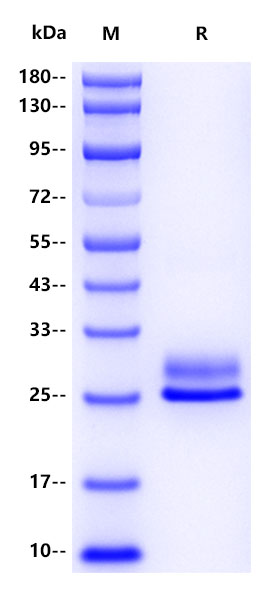Protein sequence(T2KEN6, ·Gln20-Ser223, with C-10*His) QIDLDEKAFVFPRESENSYVILFPQLQKPMKAFTVCLQVYTDLTRPHSLFSYATKSQSNEILLFKERPGLFSVSVGGSDAFINFPQKFYAPQHFCVTWESVTGLTELWVDGKPMVRASLRRGYTVGSGASIVLGQEQDSFGGGFDKNQSLVGDIEDVNMWDFVLSPSQILTLYTTRALSPNVLNWRNLRYETRGEVFLKKELWSGGGGSHHHHHHHHHH
12 months from date of receipt, -20 to -70 °C as supplied. 6 months.
-20 to -70 °C under sterile conditions after reconstitution.
1 week, 2 to 8 °C under sterile conditions after reconstitution.
Please avoid repeated freeze-thaw cycles.
C-reactive protein (CRP) is an annular (ring-shaped) pentameric protein found in blood plasma, whose circulating concentrations rise in response to inflammation. It is an acute-phase protein of hepatic origin that increases following interleukin-6 secretion by macrophages and T cells. Its physiological role is to bind to lysophosphatidylcholine expressed on the surface of dead or dying cells (and some types of bacteria) in order to activate the complement system via C1q. CRP is used mainly as an inflammation marker. Apart from liver failure, there are few known factors that interfere with CRP production. Interferon alpha inhibits CRP production from liver cells which may explain the relatively low levels of CRP found during viral infections compared to bacterial infections.

2μg(R: reducing conditions)